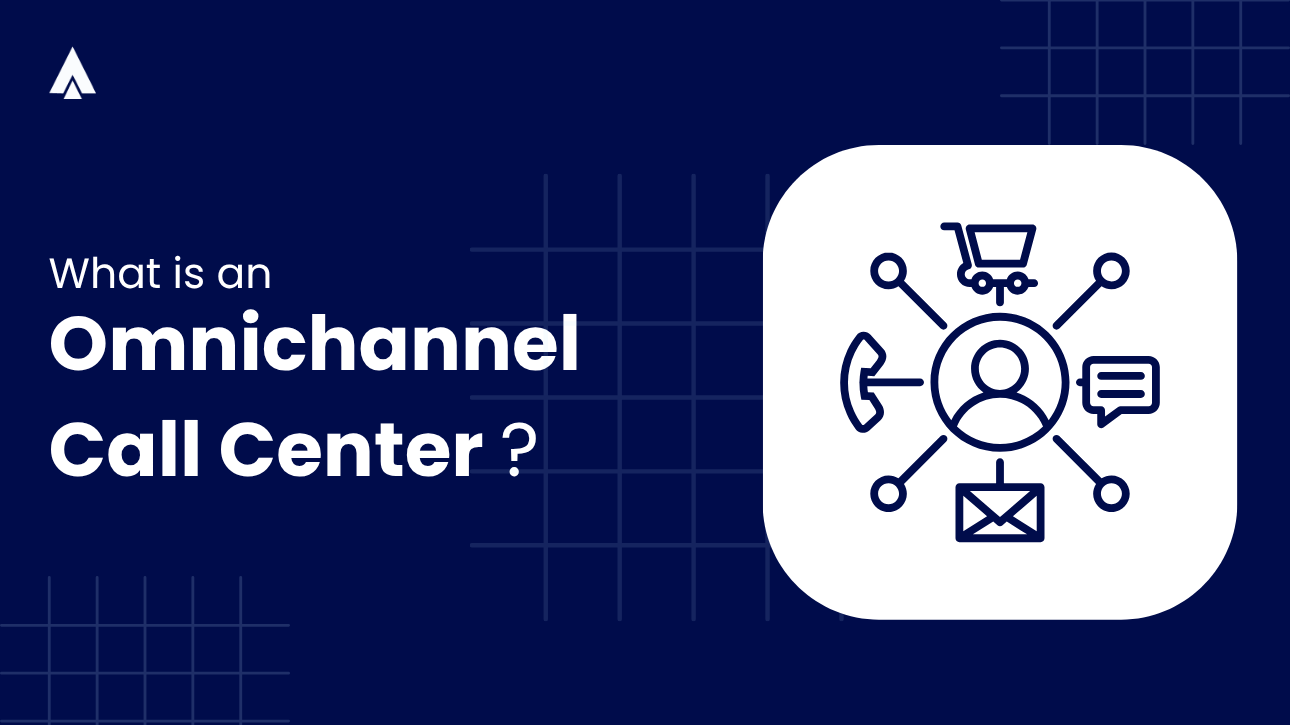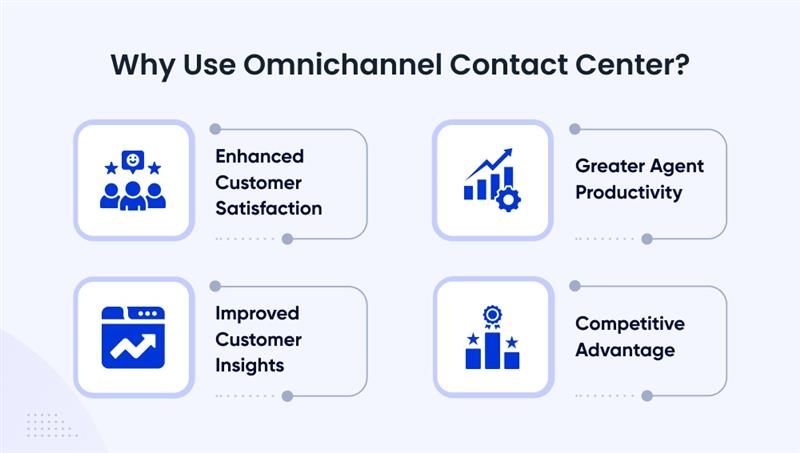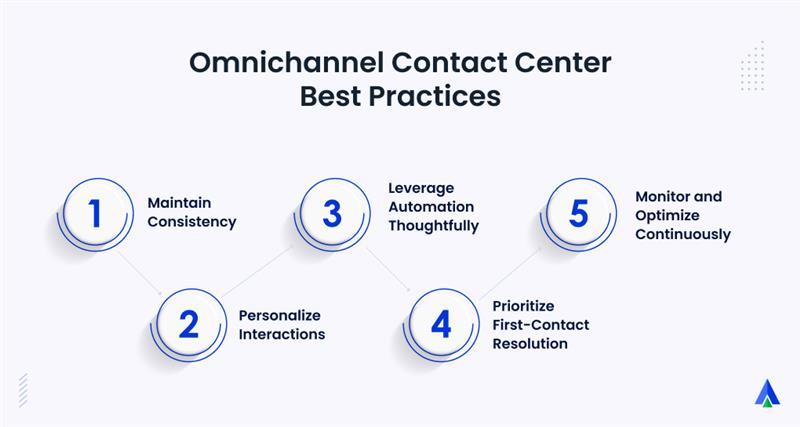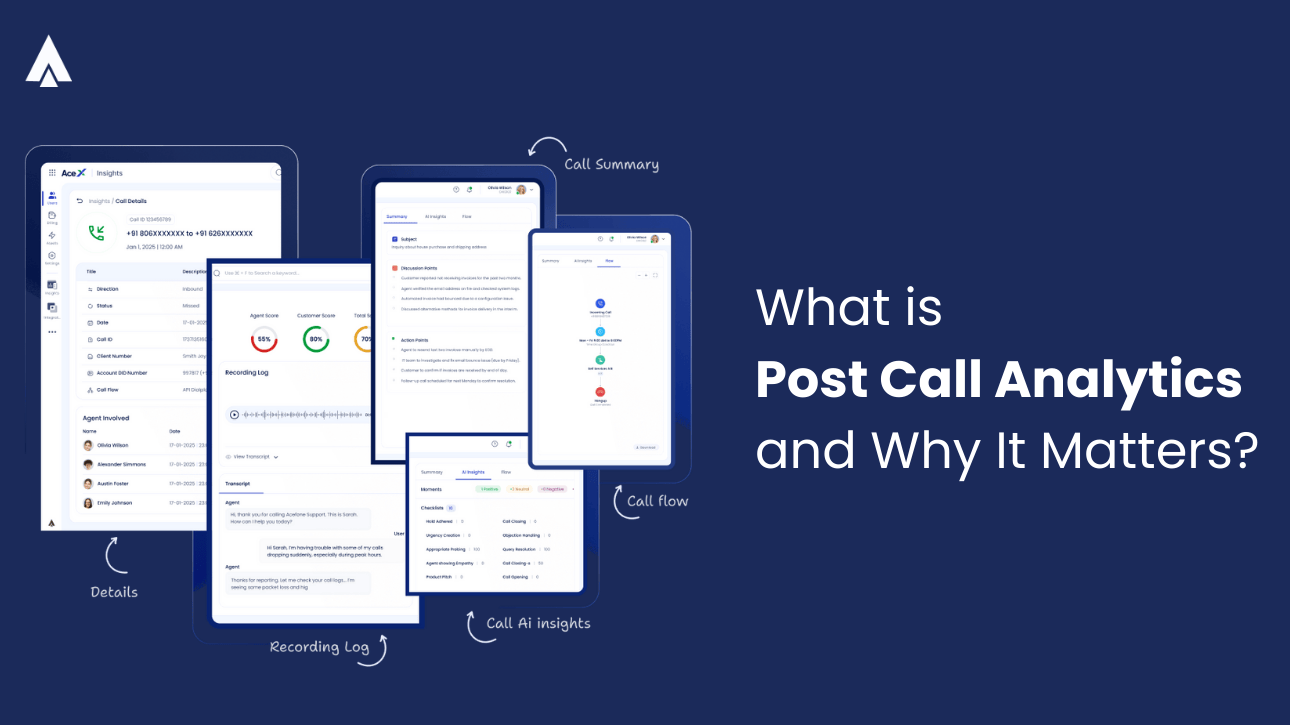Customer expectations continue to increase beyond the speed of technological development. Making exceptional customer experiences non-negotiable for businesses today.
To meet these expectations, we assessed customer behavior and concluded that an omnichannel communication strategy is a must. Since the end customer uses multiple channels to engage with any business, it only makes sense to offer them the same.
In other words, setting up an omnichannel contact center for your business is critical.
Your customers might want to connect with you via chat, voice call, email, or any other channel. To manage interactions seamlessly, you need a unified approach.
What is an omnichannel contact center?
An Omnichannel contact center is a modern contact center software solution where customers can interact with the business across multiple channels. The most common interaction channels are voice calls (VoIP or PSTN), chats, SMSs, video conferencing, emails, and social media platforms as well.
To understand how it differs from earlier models, see our post on what is a call center.
Omnichannel contact centers offer superior customer service that allows you to successfully capture more leads and retain more customers. They also make work easier for sales reps, making it easier to deliver seamless customer experiences from any channel.
Why Use Omnichannel Contact Center?
Implementing an omnichannel contact center software enables you to deliver unified, seamless customer experiences across various touchpoints. Here’s why:
- Enhanced Customer Satisfaction
Omnichannel solutions ensure agents are able to conduct smooth and consistent interactions that reduce customer frustration and increase satisfaction.
- Greater Agent Productivity
Centralized platforms allow agents quick access to customer histories, reducing the time spent switching between tools and improving response times.
- Improved Customer Insights
Placing consolidated data from multiple channels into one place enables you to better understand customer behavior. Further allowing enabling you to create tailored marketing strategies and service improvements.
- Competitive Advantage
Omnichannel contact centers offer comprehensive, integrated customer experiences that differentiate your brand from the rest.
Benefits of an Omnichannel Contact Center
In the era of smart technology, businesses cannot fail at delivering smart and seamless customer experiences. An omnichannel customer service platform is a sure-shot way to do so. Not only are you able to reach clients via platforms of their choice, you’re also able to service them through channels that they prefer.
So, if you have a customer reach out to you via email, then follow up on social media, and then ask for a resolution via WhatsApp? No problem! Your agents will always be aware of previous interactions with other agents, and the conversation will flow smoothly.
You will be known for your professionalism, your consideration towards your customers, and your reliability.
Curious how inbound vs outbound call center models fit into omnichannel strategies? Let’s discuss some of the best ways in which an omnichannel platform provides better customer service to businesses.
1. Gather customer data and insights
Whether it’s small or large, every business knows the importance of customer data and insights. Using the omnichannel approach, you can have a better understanding of your customers’ demands and behavior. This understanding will help you to deliver the best customer service to your customers.
Being a unified system, an omnichannel contact center software can gather customer data on one dashboard. You can set 10+ KPIs and monitor various metrics. For instance, if you’re wondering which service or product on your website gets the greatest number of clicks, you’ll easily be able to identify the same via detailed and visually appealing reports.
When you have all the customer insights in one place, you can create better and more effective business strategies. Needless to say, when you’re deciding on marketing strategies, these insights play an influential role.
Omnichannel solutions follow client interactions across all channels and collect vital data. This data helps identify trends and patterns, eventually enabling proactive discovery of issues and effective resolution. This results in effortless communication and a better customer rating and brand reputation.
2. Intelligent routing
The omnichannel approach integrates your cloud-backed phone system with CRM integration tools. These tools collect all customer data and information from all the previous interactions. This data helps businesses set intelligent routing strategies that ensure clients are connected to the right agents in a quick and efficient manner.
3. Improves customer experience
As the world moves towards new and advanced innovations every day, customer expectations are also increasing accordingly. Businesses should focus on understanding customers’ needs and expectations in depth. Once you have the data, you need to convert these insights into actions.
Your business strategies should meet both your business objectives and customer expectations. Through omnichannel contact center solutions that offer actionable insights, it’s easier to achieve the same while proactively eliminating bottlenecks.
These insights will help you determine customer behavior so that you can tailor your offerings accordingly and provide your audience with the best customer experience.
Omnichannel contact center platform allows your customers to engage using any device. In this way, you can focus on retention and enhance the emotional connection between the company and the customers.
4. Engage with customers in real-time
Customers expect their queries to be answered as soon as possible. And you must ensure first-call resolution. If you fail to provide real-time answers to their queries, your customers may be inclined to switch to a competitor.
Via omnichannel contact centers, you can engage with your customers in real time through chats, videos, co-browsing, and screen-sharing as well. Not just that, you can interact with them irrespective of their and your device.
Providing real-time solutions to your customers creates a good impression not just on your existing audience base but also on potential clients. This is one of the best ways to enhance your organic word-of-mouth marketing efforts.
Tips for implementing an omnichannel strategy
Implementing an omnichannel strategy requires thoughtful planning and execution. From mapping the first touchpoint to gathering customer feedback. To ensure your contact center is performing well on all ends, you can break down the implementation process into the following bits:
- Map the complete customer journey to identify areas of friction and improvement.
- Choose a platform that offers seamless integration with your desired communication channels.
- Train agents with vital insights, ensuring they understand how to manage interactions smoothly across channels.
- Start with a small setup that is easier to manage and eventually scale up by adding one channel at a time.
- Regularly gather customer feedback and agents to refine and improve your omnichannel strategy.
Considerations When Setting Up an Omnichannel Contact Center
Putting together an omnichannel contact center for your business is a huge step toward enhancing customer engagement, operational efficiency, and stronger customer relationships. To ensure you’re on the right path, you must practice careful planning and strategic considerations. Here are some key considerations to keep in mind while setting up the omnichannel contact center.
- Customer Needs
Before you get down to jotting down your requirements, you must first take note of your customers’ needs and priorities. All the way from the channels they prefer to communicate through, to their time zone.
- Budget allocation
Your budget is the second in the list of factors you must consider. Take an estimation of the overall running expenses of an omnichannel contact center, from training agents to scaling options.
- Setup & Onboarding
Contact center providers with quick setup and assisted onboarding should take priority. Given how critical every minute is in the world of operations, contact center solutions that are easy and quick to implement give you the upper hand over your competition.
- Security & Compliance
Prioritize contact center solutions with robust security measures, including data encryption, secure storage, and user-based access controls. Ensure your chosen platform complies with industry-specific regulations like GDPR, HIPAA, and other relevant standards.
- Customization & Flexibility
Make sure the contact center solution allows you ample customization to meet your specific business needs and preferences. Flexible workflow configurations, dynamic agent scripting, and automated responses can greatly enhance your overall operational efficiency.
- Vendor Support & Reliability
The contact center provider you choose to go with must provide ongoing support and agent training, ensuring a smooth transition. They must also be aligned with your business hours and be easy to reach when needed.
Essential Elements of an Omnichannel Contact Center
A well-functioning omnichannel contact center is built on several key components:
1. Cloud-based platform with a unified interface
Cloud-powered contact centers simplify complex interactions. By streamlining customer service tools, businesses can enhance efficiency and agent productivity.
2. Seamless channel integration
An omnichannel approach is effective when employees can switch between communication channels effortlessly while retaining customer history and context.
3. Data-driven personalization
Customer expectations evolve quickly. While chatbots were once rarely used, today, they are a preferred choice for quick responses. Leveraging customer insights enables more personalized interactions.
4. Smart inbound request routing
As communication channels expand, efficient routing becomes essential. Delivering a seamless experience means ensuring customers are connected to the right agent on the first attempt.
Read our blog “Omnichannel Marketing Statistics” here.
Key Features of an Omnichannel Contact Center
Now that we’ve explored what makes an omnichannel contact center platform ideal, let’s dive into the key features you should consider when selecting the right solution.
These include:
- Omnichannel routing
- Customer sentiment analysis
- Business software integration
- Analytics and reporting
- Workforce management
1. Omnichannel Routing
Omnichannel routing functions similarly to call routing, enabling administrators to define rules for directing customer inquiries to the most suitable agent—regardless of the communication channel used.
For instance, if a customer initiates a web chat about a specific product, they would be instantly connected with an available product specialist in the sales team, rather than an IT representative who may not have the relevant expertise.
The interaction would seamlessly appear on the agent’s dashboard, allowing them to respond within the omnichannel customer service platform without navigating away from their workspace.
Routing can be configured based on agent skills, round-robin distribution, idle time, and other factors.
Beyond routing, administrators can implement automated responses that acknowledge receipt of messages, share self-help resources, or provide estimated wait times. AI-driven chatbots can also assist customers in these initial interactions. For voice calls, inbound callers are directed to an IVR system that efficiently guides them to the right agent or enables self-service via voice commands.
2. Customer Sentiment Analysis
Customer sentiment analysis leverages AI-driven technology to identify speech patterns, words, and phrases that reflect customer emotions during interactions.
This feature enhances employee training and enables agents and managers to gain deeper insights into customer behavior.
For voice interactions, AI-powered Natural Language Processing (NLP) detects customer service keywords such as “billing,” “order delay,” or “refund,” helping managers recognize recurring issues and refine customer support strategies.
In text-based conversations like chat and messaging, sentiment analysis identifies key phrases and can even provide agents with relevant knowledge base articles for faster resolution.
3. Business Software Integration
A robust omnichannel customer service platform should seamlessly integrate with third-party business applications, ensuring smooth transitions between communication and operational tools.
Your cloud contact center platform should support integration with:
- CRM systems
- Project management tools
- Marketing and outreach platforms
- Collaboration tools
- Productivity suites
4. Analytics and Reporting
Comprehensive analytics empower administrators to track key performance indicators (KPIs), monitor agent productivity, and identify trends across different communication channels.
An effective omnichannel platform should offer both pre-configured and customizable reports, allowing businesses to focus on the metrics that matter most.
Key analytics include:
- First-contact resolution rate
- Average call and chat duration
- Interaction volume across channels
- Daily, weekly, and monthly inbound/outbound engagement rates
- Cost per contact
- Call handling metrics (hold time, transfer rate, speed of response)
- Contact abandonment rate
- Customer satisfaction scores (CSAT)
- Customer engagement levels
5. Workforce Management
A well-structured workforce management system within an omnichannel contact center platform enhances team efficiency and ensures a balanced workload distribution.
By combining workforce management with analytics, businesses can:
- Optimize shift scheduling and allow agents to select shifts
- Distribute workloads evenly among team members
- Forecast future trends and demand spikes
- Monitor agent availability and real-time activity
- Assign tasks based on agent skills to maintain service continuity
While many cloud contact center platforms include workforce management as an add-on, having it integrated into the system streamlines operations and improves overall performance.
Read our blog “Features of call center software” here.
Omnichannel vs Multichannel Contact Center

A multichannel contact center is a customer services approach that includes multiple communication channels such as text, voice, website, and social media and enables communication where customers spend most of their time.
Au contraire, in the case of an omnichannel contact center software, all customer interactions across various channels are integrated into one platform.
Let’s understand the key difference between omnichannel and multichannel platforms:
| Features | Omnichannel Contact Center | Multichannel Contact Center |
| Definition | Unified, seamless communication across channels. | Multiple channels operate separately. |
| Customer Experience | Consistent, context-aware interactions. | Customers may need to repeat information. |
| Channel Integration | Fully integrated channels. | Channels function independently. |
| Data Sharing | Centralized customer data across channels. | Data is siloed in separate systems. |
| Agent Efficiency | Single interface with full context. | Agents switch between multiple tools. |
| Customer Routing | Smart routing across all channels. | Channel-specific routing. |
| AI & Automation | Works across channels (chatbots, sentiment analysis). | Limited to specific channels. |
| Journey Tracking | Tracks interactions across all touchpoints. | Hard to monitor customer journeys. |
| Personalization | Data-driven, tailored experiences. | Limited personalization. |
| Best For | Businesses prioritizing seamless CX. | Companies offering basic multi-channel support. |
Omnichannel Contact Center Best Practices
To ensure your team is achieving optimal results, you must carefully manage your operations. Follow these best practices for smooth running:
1. Maintain Consistency
Ensure brand voice, messaging, and service quality remain consistent across all channels.
2. Personalize Interactions
Use customer data to personalize experiences, making customers feel valued and understood.
3. Leverage Automation Thoughtfully
Employ AI-powered tools like chatbots for routine inquiries, freeing agents to focus on complex customer interactions.
4. Prioritize First-Contact Resolution
Empower agents with training and resources to resolve customer issues on the first interaction, enhancing customer satisfaction and reducing operational costs.
5. Monitor and Optimize Continuously
Regularly analyze performance metrics and adjust strategies based on actionable insights to ensure ongoing improvement.
Read our blog “Contact Center vs Call Center” here.
Summing it up
In the customer service sector, Acefone omnichannel contact center pricing will be a trend in the upcoming decades. It reduces the workload of the contact center agent, and improves first-call resolution, thereby enhancing customer satisfaction with complete efficiency. In this approach, all communication channels are kept open until the customer’s issues are resolved.
Omnichannel has been proven to be the faster, simpler, and more customer-friendly approach in providing better customer service to businesses of all sizes.
Omnichannel Contact Center FAQs
A: Measuring costs in an omnichannel contact center involves evaluating multiple factors, such as: A: An omnichannel contact center offers cohesive and personalized interactions across all channels. It enables your customers to communicate through their preferred mediums without losing context or needing to repeat information. This seamless experience improves first-contact resolution rates (FCR), reduces customer effort, and boosts overall satisfaction. A: The best omnichannel contact center platform offers seamless channel integration, workflow automation, smart routing, real-time analytics, CRM compatibility, and a unified interface. Acefone delivers all these features, ensuring effortless customer interactions, enhanced agent productivity, and superior customer experience, making it the ideal choice for businesses seeking excellence in omnichannel customer experience.
A: Yes, Omnichannel contact centers can easily be integrated with your existing systems, including CRMs, marketing automation tools, ERP platforms, and productivity suites. This integration ensures that all customer interactions are synchronized, providing agents with real-time, comprehensive customer insights, thus enabling more personalized and efficient interactions.
A: The cost of an omnichannel contact center solution varies based on the features, active user count, and customization needs. Cloud-based models offer flexible omnichannel contact center software pricing, typically on a subscription basis. Investing in a scalable omnichannel contact center solution ensures cost-effectiveness while meeting dynamic business requirements.
A: Yes, a scalable omnichannel platform like Acefone allows you to add communication channels as needed. With our flexible cloud contact center providers, you get effortless integration of new channels without disrupting existing workflows, enhancing overall customer engagement.
















